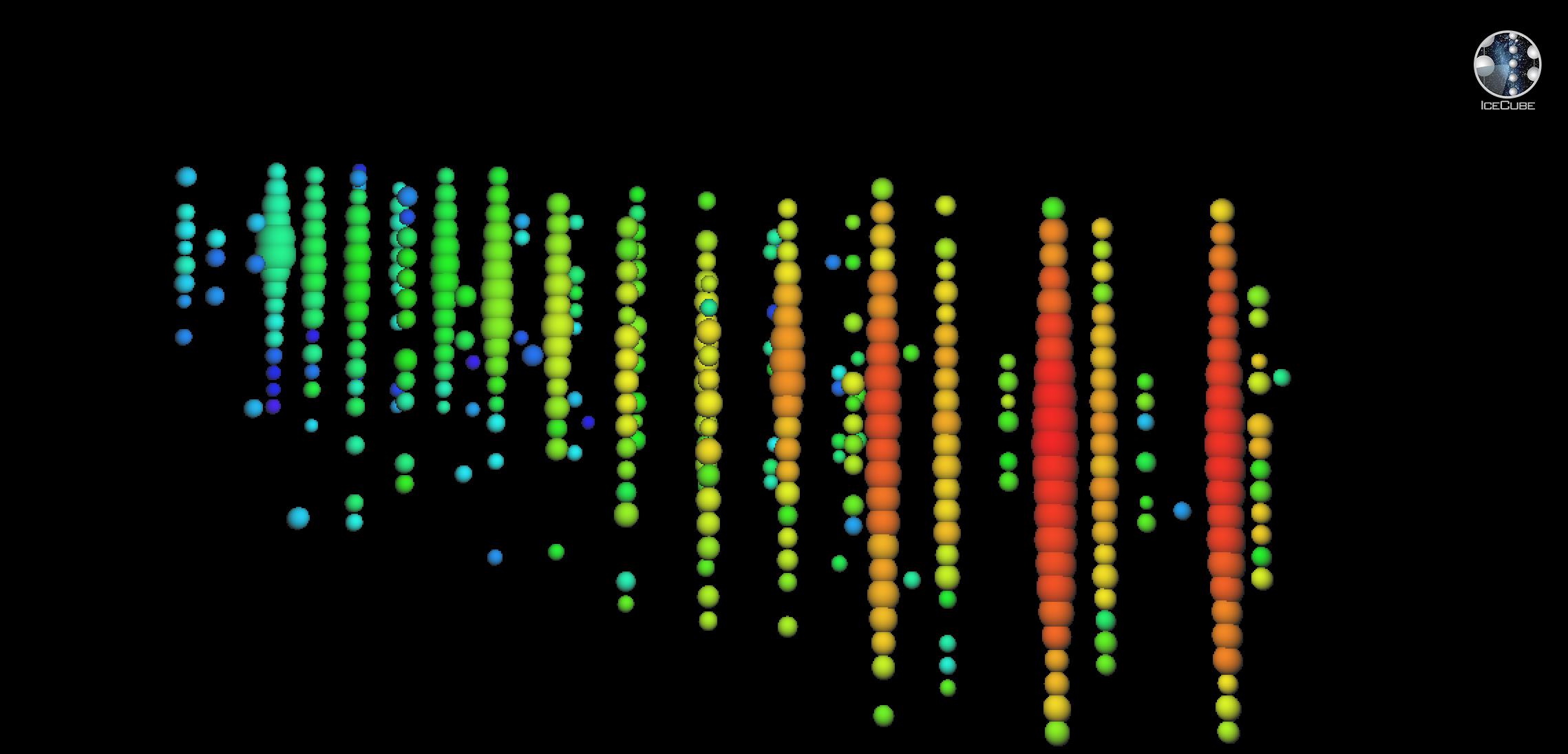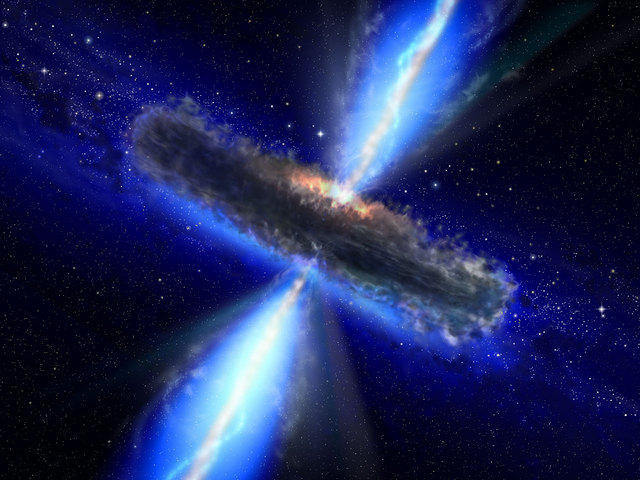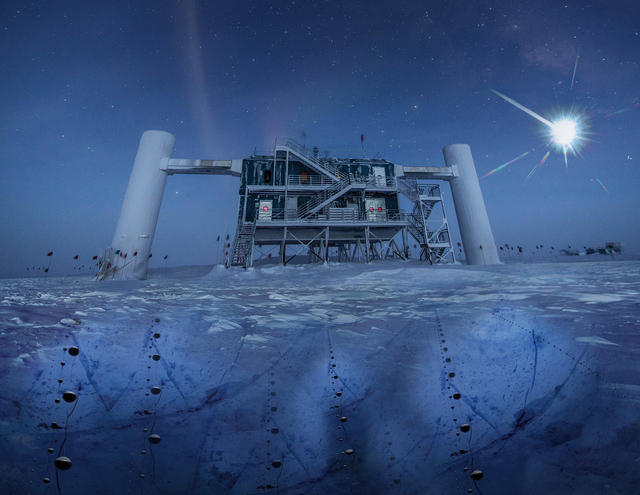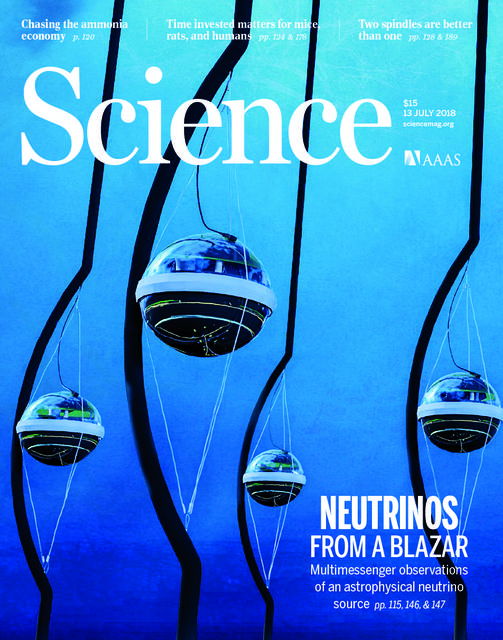VIDEO: “The first source of high-energy neutrinos.” This video explains the observations that led to the identification of the first source of high-energy neutrinos and cosmic rays. These results help us answer a 100-year-old riddle: Where and how does nature accelerate particles to the highest energies ever detected? (Credit: Ice Cube Collaboration, National Science Foundation)
Note: This press release was adapted from a release produced by the IceCube Collaboration. Read the original release.
An international team of scientists has found the first evidence of a source of high-energy cosmic neutrinos, ghostly subatomic particles that can travel unhindered for billions of light years from the most extreme environments in the universe to Earth.
The observations, made by the IceCube Neutrino Observatory at the Amundsen–Scott South Pole Station and confirmed by telescopes around the globe and in Earth’s orbit, help resolve a more than a century-old riddle about what sends subatomic particles such as neutrinos and cosmic rays speeding through the universe.
Q&A: Berkeley Lab’s Spencer Klein Talks About IceCube Then and Now, and What’s Next
In this Q&A, Berkeley Lab physicist Spencer Klein, who has been a part of the IceCube collaboration since 2004, discusses Berkeley Lab’s historic contributions to IceCube, and IceCube’s contributions to science.
Q: How is this new result important for the field of astrophysics?
A: This search, for the first time, points us to the super-energetic particle accelerators that we know exist in our galaxy. These accelerators can emit particles with energies a billion times higher in energy than CERN’s Large Hadron Collider, the most energetic human-made particle accelerator.
Since they were first detected over 100 years ago, cosmic rays – highly energetic particles that continuously rain down on Earth from space – have posed an enduring mystery: What creates and launches these particles across such vast distances? Where do they come from? How are they accelerated to such high energies?
A single cosmic-ray proton (or heavier nucleus) can carry enough energy to light a 50-watt light bulb for one second. The powerful cosmic accelerators that produce them will also produce neutrinos.
While cosmic rays are electrically charged – they are bent in the magnetic fields that fill space – neutrinos are electrically neutral and are unaffected by magnetic fields. Because they rarely interact with matter, neutrinos travel nearly undisturbed from their accelerators, giving scientists an almost direct pointer to their source.
Two papers published this week in the journal Science (view them here and here) have for the first time provided evidence for a known blazar – a giant elliptical galaxy with a massive, rapidly spinning black hole at its core – as a source of high-energy neutrinos detected by the National Science Foundation (NSF)-supported IceCube observatory. This blazar, designated by astronomers as TXS 0506+056, was first singled out following a neutrino alert sent by IceCube on Sept. 22, 2017.
“The evidence for the observation of the first known source of high-energy neutrinos and cosmic rays is compelling,” said Francis Halzen, a University of Wisconsin–Madison professor of physics and the lead scientist for the IceCube Neutrino Observatory.
“The era of multimessenger astrophysics is here,” said NSF Director France Córdova. “Each messenger – from electromagnetic radiation, gravitational waves, and now neutrinos – gives us a more complete understanding of the universe, and important new insights into the most powerful objects and events in the sky. Such breakthroughs are only possible through a long-term commitment to fundamental research and investment in superb research facilities.”
A signature feature of blazars is that twin jets of light and elementary particles, one of which is pointing to Earth, are emitted from the poles along the axis of the black hole’s rotation. TXS 0506+056 is situated in the night sky just off the left shoulder of the constellation Orion and is about 4 billion light-years from Earth.

This image shows a data visualization associated with a high-energy neutrino detected by IceCube on Sept. 22, 2017 with an estimated energy of 290 TeV (290 trillion electron volts). The neutrino event display shows a muon, created by the interaction of a neutrino with the ice very close to IceCube, which leaves a track of light while crossing the detector. The light collected by each sensor is represented by a colored sphere. The color gradient, from red to green/blue, shows the time sequence. (Credit: IceCube Collaboration)
Equipped with an alert system that is triggered when a very high-energy neutrino collides with an atomic nucleus in the Antarctic ice in or near the IceCube detector, the observatory broadcasted coordinates of the Sept. 22 neutrino alert to telescopes worldwide for follow-up observations. Gamma-ray observatories, including NASA’s orbiting Fermi Gamma-ray Space Telescope and the Major Atmospheric Gamma Imaging Cherenkov Telescope, or MAGIC, in the Canary Islands, detected a flare of high-energy gamma rays associated with TXS 0506+056, a convergence of observations that convincingly implicated the blazar as the most likely source.
Fermi was the first telescope to identify enhanced gamma-ray activity from TXS 0506+056 within 0.06 degrees of the IceCube neutrino direction. In a decade of Fermi observations of this source, this was the strongest flare in gamma rays, the highest-energy photons. A later follow-up by MAGIC detected even more energetic gamma rays.
These observations prove that TXS 056+056 is one of the most luminous sources in the known universe, and thus add support to a multimessenger observation of a cosmic engine powerful enough to accelerate high-energy cosmic rays and produce the associated neutrinos. Only one of these neutrinos, out of many millions that sailed through Antarctica’s ice, was detected by IceCube on Sept. 22.
Bolstering these observations are coincident measurements from other instruments, including optical, radio, and X-ray telescopes. “The ability to globally marshal telescopes to make a discovery using a variety of wavelengths in cooperation with a neutrino detector like IceCube marks a milestone … in multimessenger astronomy,” said Halzen.
“These intriguing results also represent the remarkable culmination of thousands of human years of intensive activities by the IceCube Collaboration to bring the dream of neutrino astronomy to reality,” said Darren Grant, a professor of physics at the University of Alberta and the spokesperson of the IceCube Collaboration, an international team with over 300 scientists in 12 countries.

This artist’s impression shows the dust torus around a super-massive black hole. Black holes lurk at the centers of active galaxies. The jets emerge from an area close to the black hole where a disk of accreted material rotates. (Credit: ESA/NASA, the AVO project and Paolo Padovani)
Scientists have spent decades searching for the astrophysical accelerators that generate these particles. Now, they have located at least one such accelerator. Scientists had speculated that the most violent objects in the cosmos – like supernova remnants, colliding galaxies, and the energetic black hole cores of galaxies known as active galactic nuclei, such as blazars – could be the sources.
“Now, we have identified at least one source of cosmic rays because it produces cosmic neutrinos. Neutrinos are the decay products of pions. In order to produce them, you need a proton accelerator,” said Halzen. “Theories predict that the emission of neutrinos will be accompanied by the release of gamma rays,” explains Razmik Mirzoyan, the spokesperson of the MAGIC Collaboration. But there are still a lot of questions on how blazars could accelerate particles to such high energies.
As the latest astrophysical messenger to enter the game, neutrinos bring crucial new information to uncovering the inner workings of these cosmic ray accelerators. In particular, measurements of neutrinos can reveal the mechanisms for particle acceleration of the proton beam in the densest environments that even high-energy gamma rays may not escape.
Following the Sept. 22 detection, the IceCube team quickly scoured the detector’s archival data and discovered a flare of over a dozen astrophysical neutrinos detected in late 2014 and early 2015, coincident with the same blazar, TXS 0506+056. This independent observation greatly strengthens the initial detection of a single high-energy neutrino and adds to a growing body of data that indicates TXS 0506+056 is the first known accelerator of the highest energy neutrinos and cosmic rays.
Detecting the highest energy neutrinos requires a massive particle detector, and IceCube is by volume the world’s largest. Encompassing a cubic kilometer of deep, pristine ice a mile beneath the surface at the South Pole, the detector is composed of more than 5,000 independent detectors (called digital optical modules, or DOMs) arranged in a grid. When a neutrino interacts with the ice, it creates secondary charged particles, which produce blue light that is detected by the IceCube DOMs. By observing when the light arrives at the DOMs, scientists can determine the neutrino direction and estimate its energy.
The DOMs function much like small space satellites. They are each equipped with an optical sensor (a photomultiplier tube) and an autonomous data-acquisition system, and automatically perform their own calibrations. They receive commands from the surface while transmitting digital data to the surface that is neatly grouped for easy use by the computers on the surface.
Since the DOMs are completely inaccessible, buried under a mile of Antarctic ice, they must be extremely reliable while operating at extreme temperatures and consuming little power.

In this artistic composition, based on a real image of the IceCube Lab at the South Pole, a distant source emits neutrinos that are detected below the ice by IceCube sensors, called digital optical modules (DOMs). (Credit: IceCube/NSF)
IceCube is almost always on, continuously monitoring the sky, including through the Earth to the Northern Hemisphere. It detects a neutrino every few minutes. Most of the neutrinos it detects, however, are low energy, created by more common phenomena, such as the showers of subatomic particles stemming from cosmic ray particles crashing into atomic nuclei in the Earth’s atmosphere.
Particles of particular interest to the IceCube team pack a more energetic punch. The neutrino that alerted telescopes around the world had an energy of approximately 300 trillion electron volts (also known as tera electron volts, or TeV. By comparison, the energy of the protons circulating in the 26.7-kilometer ring of the world’s most powerful particle accelerator, CERN’s Large Hadron Collider, is 6.5 TeV.
IceCube was built specifically to identify and track high-energy neutrinos. In 2013, the collaboration announced the detection of the first neutrinos from beyond our galaxy and since has since made numerous fundamental measurements in the emerging field of neutrino astronomy.
In addition to studying the cosmos, the collaboration studies how neutrinos interact at energies far above those that are accessible at human-made particle accelerators. The collaboration last year announced the first measurement of neutrino absorption in the Earth, proving that highly energetic neutrinos do not go through everything.
The IceCube team also analyzes lower-energy neutrinos, with outstanding results that are helping scientists make sense of matter in its most elementary forms, and studies what happens when the neutrinos interact in the detector.

This Science journal cover image features an artist’s impression of the IceCube Neutrino Observatory in Antarctica. Spherical digital optical modules (DOMs), each about 35 centimeters in diameter, are positioned up to 2.5 kilometers deep in the ice. More than 5,000 DOMs make up a cubic-kilometer detector weighing more than a billion tons. The DOMs detect the faint flash of light created when a high-energy neutrino interacts with the ice. (Credit: Jamie Yang and Savannah Guthrie/IceCube/NSF)
Berkeley Lab researchers played a vital role in IceCube construction, pioneering the DOM concept, building a prototype system to prove that it worked, and designing and building the main circuit board (motherboard) electronics that enable a revolutionary self-contained data-acquisition system for each of the more than 5,000 DOMs.
“This was a Lab-wide effort involving expertise from the Nuclear Science, Physics, Engineering, and Computing divisions,” said Nuclear Science Division physicist Bob Stokstad who, along with David Nygren of the Physics Division, played a key role in fostering Berkeley Lab’s involvement in IceCube.
“The Lab’s ability to design state-of-the art digital electronics and test it extensively explains why 98 percent of the approximately 5,000 successfully deployed DOMs continue to provide high-quality data after a decade of operation deep in South Pole ice.”
Thorsten Stezelberger, a Lab electrical engineer who worked on IceCube electronics and made four trips to the South Pole to support the experiment’s early testing and installation of the DOMs, said, “It’s an interesting project in a challenging environment.”
He added, “Knowing that you built electronics going 2.5 kilometers down in the ice, and they have to work – you cannot send somebody down with a shovel and say, ‘Dig down, we have to fix something’ – it’s really amazing how well it all works.” Lab scientists and engineers drew upon lessons from NASA spacecraft to identify reliable manufacturers and parts that could withstand the rigors of a cold and remote environment.
Berkeley Lab researchers also played a significant role in IceCube computing, writing software for data acquisition and analysis. Additionally, Berkeley Lab’s National Energy Research Scientific Computing Center (NERSC) provides computing cycles for IceCube and also serves as a repository for all of the IceCube raw data – more than 2,200 terabytes to date. NERSC is a DOE Office of Science User Facility.
The IceCube Neutrino Observatory is funded primarily by the National Science Foundation and is operated by a team headquartered at the University of Wisconsin–Madison. IceCube construction was also funded with significant contributions from the National Fund for Scientific Research in Belgium; the Federal Ministry of Education and Research and the German Research Foundation in Germany; the Knut and Alice Wallenberg Foundation, the Swedish Polar Research Secretariat, and the Swedish Research Council in Sweden; and the Department of Energy and the University of Wisconsin–Madison Research Fund in the U.S.
The IceCube Collaboration, with over 300 scientists in 49 institutions from around the world, runs an extensive scientific program that has established the foundations of neutrino astronomy. Its research efforts, including critical contributions to the detector operation, are funded by funding agencies in Australia, Belgium, Canada, Denmark, Germany, Japan, New Zealand, the Republic of Korea, Sweden, Switzerland, the U.K., and the U.S.
About 20 observatories on Earth and in space have participated in the identification of what scientists deem to be a source of very-high-energy neutrinos and, thus, of cosmic rays. The observations across the electromagnetic spectrum, listed alphabetically by project for the given wavelength, include: gamma-rays by the space missions AGILE, INTEGRAL, and Fermi and ground-based telescopes HAWC in Mexico, H.E.S.S. in Namibia, MAGIC in Spain, and VERITAS in the U.S.; X-rays, optical, and radio radiation by space missions MAXI, NuSTAR, and Swift and ground-based observatories ASAS-SN in Chile and the U.S., GTC in Spain, Kanata in Japan, Kapteyn in Spain and the U.S, Kiso in Japan, Liverpool in Spain, OVRO in the U.S., SALT in South Africa, Subaru in Japan, and VLA in the U.S; and neutrinos by ANTARES in France. These observatories are run by international teams with a total of over 1,000 scientists supported by funding agencies in countries around the world. Several follow-up observations are detailed in a few other papers that are also released today.
More:
- Read a related Q&A with Berkeley Lab physicist Spencer Klein
- View more images and videos related to the latest IceCube result
###
Lawrence Berkeley National Laboratory addresses the world’s most urgent scientific challenges by advancing sustainable energy, protecting human health, creating new materials, and revealing the origin and fate of the universe. Founded in 1931, Berkeley Lab’s scientific expertise has been recognized with 13 Nobel Prizes. The University of California manages Berkeley Lab for the U.S. Department of Energy’s Office of Science. For more, visit http://www.lbl.gov.
DOE’s Office of Science is the single largest supporter of basic research in the physical sciences in the United States, and is working to address some of the most pressing challenges of our time. For more information, please visit science.energy.gov.
